Lampadioteuthinae , Lampadioteuthis
Lampadioteuthis megaleia
Richard E. Young and Michael VecchioneIntroduction
L. megaleia is a small, colorful squid that differs from other lycoteuthids, among other characters, in the presence of a hectocotylus and a rostrum on the gladius.
Brief diagnosis:
A lycoteuthid...
- with four ocular photophores.
- with stalked photophore at base of each tentacle.
Characteristics
- Arms
- Right ventral arm hectocotylized in males with enlarged protective membrane in mid-arm.
- Head
- Beaks: Descriptions can be found here: Lower beak; upper beak.
- Beaks: Descriptions can be found here: Lower beak; upper beak.
- Photophores.
- Ocular and tentacular photophores
- Four ocular organs: 3 ventral in a line, 1 lateral.
- Five tentacular organs, basal organ raised above stalk.
 Click on an image to view larger version & data in a new window
Click on an image to view larger version & data in a new window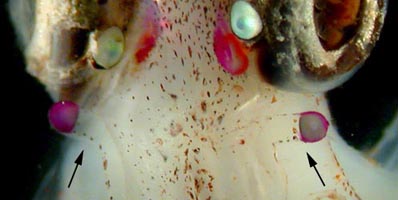
Figure. Ventral view on anterior portion of head and base of brachial crown of a 27 mm ML L. megaleia. Arrows point to stalks of basal tentacle photophores. Photograph by R. Young, R/V G. O. Sars, Mar-Eco cruise, central North Atlantic.
- Visceral photophores
- Circular anal photophores lie on either side of rectum.
- Branchial photophores, transversely elongate, each lies at base of one gill.
- Abdominal photophores absent.
- Postero-abdominal photophore, single, lies in medial line attached to inner surface of mantle and visceral mass.
 Click on an image to view larger version & data in a new window
Click on an image to view larger version & data in a new window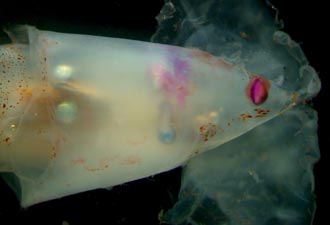
Figure. Ventral view of the mantle of a damaged but fresh L. megaleia, 27 mm ML, showing the visceral photophores through the translucent muscle. The elongate right branchial photophore has a bluish region at one end. Photograph by R. Young, R/V G. O. Sars, Mar-Eco cruise, central North Atlantic.
- Ocular and tentacular photophores
- Pigmentation
- Squid with numerous functional chromatophores.
- External skin overlying photophores with violet pigment.
 Click on an image to view larger version & data in a new window
Click on an image to view larger version & data in a new window
Figure. Ventro-lateral view of L. megaleia, same specimen as in title photograph. Note the violet patches on the mantle covering the posterior visceral photophores (skin over the anal photophores has been lost due to damage), the ocular photophores (damage has moved the skin away from some photophores) and the tentacular photophores.
- Gladius
- Rostrum present.
- Viscera
- Single penis present in males.


Figure. Ventral view of the mantle cavity of L. megaleia, preserved, central North Atlantic, showing visceral photophores. Left arrow - anal photophore. Middle arrow - branchial photophore. Right arrow - postero-abdominal photophore which was damaged while cutting open the mantle. Photograph by R. Young.
Comments
Drawings of the tentacular club and the club and arm suckers can be found here.
The violet pigment overlying the photophores presumably acts as a color filter to allow the bioluminescence to more closely match the color of the downwelling sun or moonlight. The same type of "detached" filter appears to be present in the photophores of species of Lycoteuthis.
Life History
The small squid, 8 mm ML (an advanced paralarva ?), below is virtually a minature subadult in appearance except for some differences in body proportions, size of photophores and the absence of all but the large basal photophore on the tentacle. Note presence of this photophore at the base of the tentacle in the drawing (arrow).
Distribution
Type locality: Washed ashore at Sunday Island, Kermadec Islands, South Pacific. This species is known from the subtropical North Atlantic and the Southwestern Pacific (Nesis, 1982/87).
References
Nesis, K. N. 1982/87. Abridged key to the cephalopod mollusks of the world's ocean. 385,ii pp. Light and Food Industry Publishing House, Moscow. (In Russian.). Translated into English by B. S. Levitov, ed. by L. A. Burgess (1987), Cephalopods of the world. T. F. H. Publications, Neptune City, NJ, 351pp.
Toll, R.B. 1982. The comparative morphology of the gladius in the Order Teuthoidea (Mollusca: Cephalopoda) in relation to systematics and phylogeny. PhD. Dissertation, University of Miami, 390 pp.
Voss, G. L. 1962. A monograph of the Cephalopoda of the North Atlantic. I. The Family Lycoteuthidae. Bull. Mar. Sci. Gulf Carib. 12: 264-305.
Young, R.E. 1964. A note on three specimens of the squid, Lampadioteuthis megaleia Berry, 1916 (Cephalopoda:Oegopsida) from the Atlantic Ocean, with a description of the male. Bull. Mar. Sci. Gulf Carib., 14(3):444-452.
Title Illustrations

| Scientific Name | Lampadioteuthis megaleia |
|---|---|
| Comments | Photographed aboard the R/V G. O. Sars, Mar-Eco cruise, central North Atlantic. |
| View | Ventrolateral |
| Image Use |
 This media file is licensed under the Creative Commons Attribution-NonCommercial License - Version 3.0. This media file is licensed under the Creative Commons Attribution-NonCommercial License - Version 3.0.
|
| Copyright |
© 2004

|
| Scientific Name | Lampadioteuthis megaleia |
|---|---|
| Location | 40°46'N, 18°35'W, North Atlantic |
| Reference | Young, R.E. 1964. A note on three specimens of the squid, Lampadioteuthis megaleia Berry, 1916 (Cephalopoda:Oegopsida) from the Atlantic Ocean, with a description of the male. Bull. Mar. Sci. Gulf Carib., 14(3):444-452. |
| Acknowledgements | Printed with the Permission of the Bulletin of Marine Science. |
| View | Ventral |
| Image Use |
 This media file is licensed under the Creative Commons Attribution-NonCommercial License - Version 3.0. This media file is licensed under the Creative Commons Attribution-NonCommercial License - Version 3.0.
|
| Copyright |
© 2004

|
About This Page
Drawings printed with the Permission of the Bulletin of Marine Science.

University of Hawaii, Honolulu, HI, USA

National Museum of Natural History, Washington, D. C. , USA
Page copyright © 2019 and
 Page: Tree of Life
Lampadioteuthinae , Lampadioteuthis . Lampadioteuthis megaleia .
Authored by
Richard E. Young and Michael Vecchione.
The TEXT of this page is licensed under the
Creative Commons Attribution-NonCommercial License - Version 3.0. Note that images and other media
featured on this page are each governed by their own license, and they may or may not be available
for reuse. Click on an image or a media link to access the media data window, which provides the
relevant licensing information. For the general terms and conditions of ToL material reuse and
redistribution, please see the Tree of Life Copyright
Policies.
Page: Tree of Life
Lampadioteuthinae , Lampadioteuthis . Lampadioteuthis megaleia .
Authored by
Richard E. Young and Michael Vecchione.
The TEXT of this page is licensed under the
Creative Commons Attribution-NonCommercial License - Version 3.0. Note that images and other media
featured on this page are each governed by their own license, and they may or may not be available
for reuse. Click on an image or a media link to access the media data window, which provides the
relevant licensing information. For the general terms and conditions of ToL material reuse and
redistribution, please see the Tree of Life Copyright
Policies.
- Content changed 16 November 2016
Citing this page:
Young, Richard E. and Michael Vecchione. 2016. Lampadioteuthinae , Lampadioteuthis . Lampadioteuthis megaleia . Version 16 November 2016. http://tolweb.org/Lampadioteuthis_megaleia/19730/2016.11.16 in The Tree of Life Web Project, http://tolweb.org/





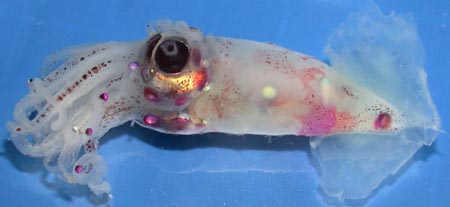
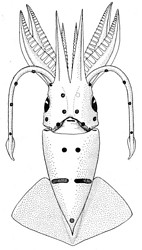
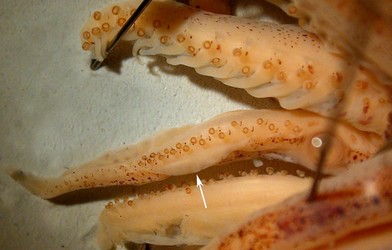
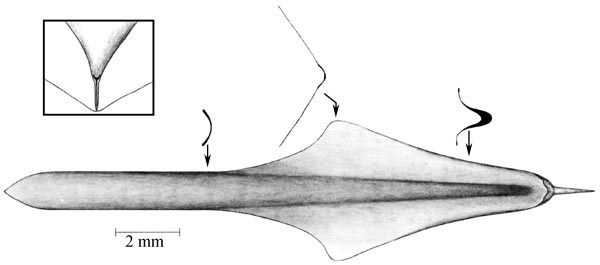
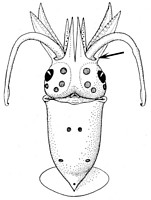




 Go to quick links
Go to quick search
Go to navigation for this section of the ToL site
Go to detailed links for the ToL site
Go to quick links
Go to quick search
Go to navigation for this section of the ToL site
Go to detailed links for the ToL site